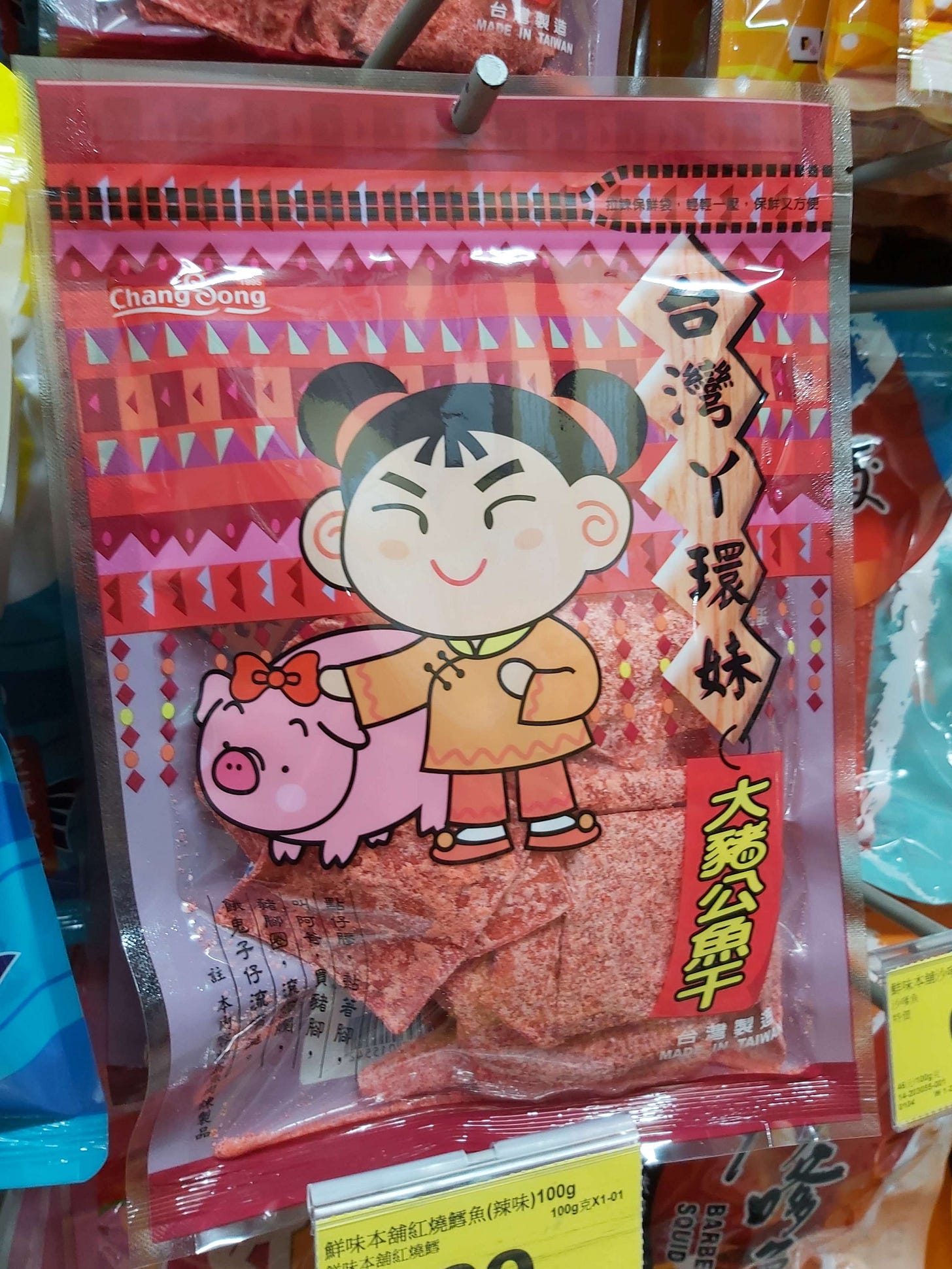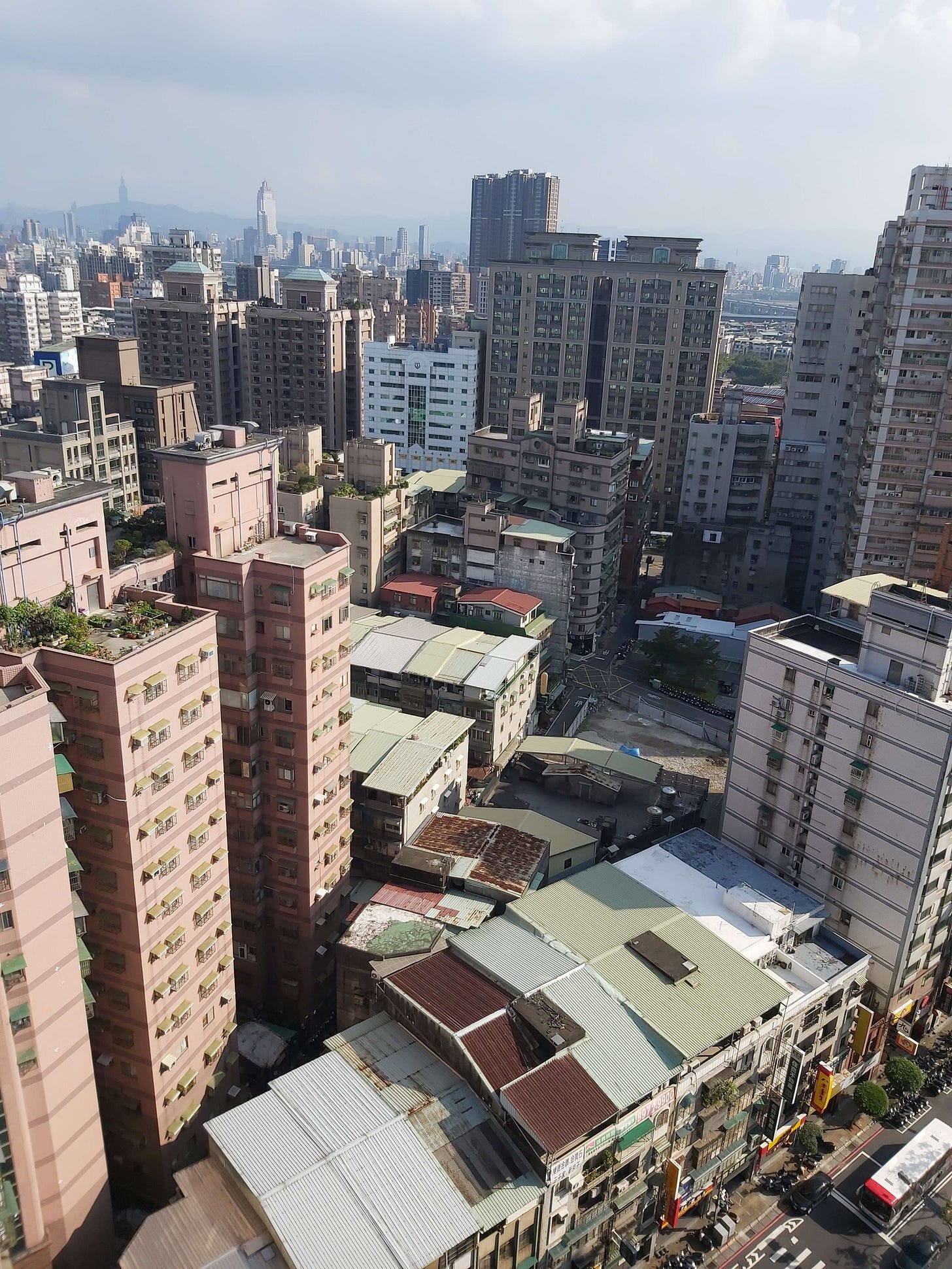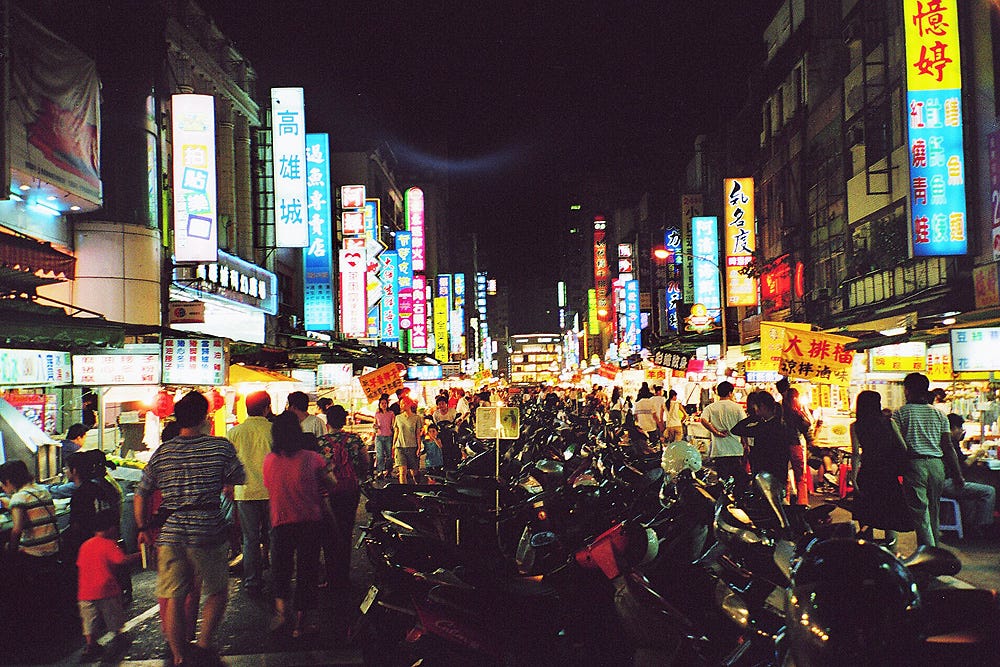My wife and two young children are one week into my roughly three-month research sabbatical in Taiwan, studying their public sector’s use of data and AI. Most of the last week has been spent settling into our new apartment, exploring the local playgrounds, markets, eateries, and seeing friends.
As one might expect, life here is very different with a family as compared with my last visit. Getting around remains relatively easy, given the excellent transport options, but there are some unexpected challenges that I’m still getting my head around. Perhaps you might have some insight or further questions. I’m hoping my next three months will be partially guided by you letting me know what is of interest and worthy of further exploration.
The climate at this time of year is very pleasant, with temperatures ranging between highs of around 22, down to about 15C overnight. Humidity is on the high side, without being unpleasant. November - Feburary is a ‘dry season’ as well, making exploration on foot easier. A great time to visit, if you’re thinking of making the trip.
Unfortunately, climate change is exacerbating water resource issues, and beginning to cause significant issues with drought over these months. For the last three years, farmers in the South of the country have been unable to plant their crops, making the island more reliant on imported agriculture, and consequently more strategically vulnerable to blockade.
As you’d expect, imported Western food is quite expensive, but it’s possible to eat very well quite cheaply here. I’ve been particularly impressed by the variety of mushrooms at the supermarket is incredible, and adds a variety of textures to cooking. I guess we lack the market for them to be grown and distributed at scale back home?

As I’ve talked about, it’s easy to be impressed by the Taipei MRT, but the busses are even better over shorter distances. Around half the fleet seems electrified, presumably on a rolling-renewal basis1. Most trips cost around $0.5USD, and it conveniently uses the same tag on/off card as the rest of the public transport network. Efficiency is again the watchword of patrons and drivers alike. People are lined up and are tagging off as they approach their stop. The drivers hustle like it’s their last run before knocking off, closing the doors and accelerating aggressively as soon as the last passenger is aboard2. Hold on tight!
Sticking with revisiting transport: I also previously talked about the poor state of the footpaths here in Taipei. Last time we were in Songshan, a newer neighbourhood full of upmarket hotels. Living now in an older residential neighbourhood, the footpaths are often purely theoretical, with enough businesses spilling their scooter repair work/hot pot eatery onto the footpath that it’s common to be forced out into the traffic lane (remembering that there’s usually a thicket of scooters parked on the road shoulder in the gutter).
In 2022, Taiwan had 375,000 traffic accidents, half a million injuries and 3,085 deaths on the road. It’s a per-capita fatality rate twice that of New Zealand, and four times higher than Japan. The injury rate discrepancy is even greater, at eight times that of New Zealand3. We lived in Thailand for a year, which has among the most dangerous roads in the world, so these conditions are not unfamiliar. However, it’s our first time experiencing it with small children, who’re prone to behave eratically. It forces a state of constant vigilance, which ultimately makes outings more tiring than they otherwise would be. For one thing, I can’t see the rationale for allowing mopeds through the dense throngs of people and stalls at night markets.
Taipei is a city that caters extremely well to young professionals. Trendy bars, michellin star restaurants, great museums and art, and glimpses of the future waiting for you around every corner. Unfortunately, the same cannot be said for how it provides for young families.
With a few notable exceptions, amenities like playgrounds are smaller and less numerous than in low-density Western suburbia. Our district of some 400,000 people has a mega-complex equipped with a olympic-sized swimming pool, a huge spa area, dry saunas, steam saunas, and… a tiny 30cm deep paddling pool with a tiny slide, which is all that’s provided for all children under 12.
Older generations are very tolerant and indulgent of our kids, but attitudes of the middle-aged are much more mixed. We’ve been snapped at by other passengers for being too loud when entering the bus, and when our kids decided to moving foam elements of an indoor playground around to form their own structures. Whether on the street, MRT, or in stores, my impression is that children are expected to be calm and reserved.
To be clear, I understand that we’re guests here and I have zero sense of entitlement about how we should be treated. I only bring it up because I think the standards Taiwanese society places on parents to control their children in public are very high, and this in turn makes parental life one of high stress, particularly with more than one child (you’re increasingly outnumbered, especially if one parent is away at work).
Taiwanese birthrates have been among the lowest in the world for the last 25 years, creating an inverted population pyramid that already guarantees massive challenges for the small nation as the middle-aged retire and are replaced by a generation half the size. Should the trend continue, as it thus far seems likely to, economic collapse is likely within a generation without massive immigration to fill the ranks of the service and manufacturing workers required to sustain a modern economy, especially one with a huge population of retirees to support.

Another driver for the low birthrate is a severe housing crisis. Taipei has a skyline dominated by tall buildings in every direction, which conceals the reality of an chronic shortage of housing across the island. Renting a one-bedroom apartment is expensive, but for young couples looking for stability and a larger residence to raise children, the situation borders on the impossible without parental assistance.
The cost of a simple two-bedroom apartment in a lower-amenity area outside the city centre runs to over $500,000USD. The cost of living is generally lower thanks to cheap transport and food, but with a median wage of only ~$30k, Taiwanese housing is amongst the least affordable in the world. I confess I’ve yet to get a good handle on why this is exactly. News and journal articles served by simple Google searches discuss the effects of low interest rates and speculators, but I’ve yet to gain much insight into supply/demand fundamentals - given high prices, why has supply not risen to meet demand?
I’ve yet to find good data on apartment construction costs, but using public sector costs as a proxy: the 15.7km circular line metro extension through an existing urban area is expected to cost ~$1.7b USD, at approximately $110m/km, broadly comparable with other South/East Asian cities, and 1/5th to a 1/10th that of Europe and the US respectively. While not directly comparable, public infrastructure is typically delivered at a substantial premium to private developments, so I would be surprised if the opposite was true here in Taiwan, but it’s another area I intend to look into further.
A more likely candidate for high apartment costs is the lack of release of new ‘greenfield’ land for housing4, and a surprisingly restrictive zoning regime. Looking out across the Taipei skyline, one sees tall apartment buildings in every direction, and it’s easy to assume that these can be built everywhere. In fact, Taipei’s zoning typically only allows these to be built along main throughfares. Everywhere else is restricted to around five stories, as you can see in the zoning map of central Taipei below.

This explains the ‘apartment buildings everywhere’ look, as well as the state of the gaps between5. These buildings are older, lower, and often poorly maintained. My intuition here is that these sites would be otherwise ideal for new apartment blocks, but are generally uneconomic to redevelop given the height restrictions that mean no additional capacity can be provided. Instead, these buildings are left to moulder, providing a fraction of the housing capacity that Taiwan needs them to.

One element the zoning regime absolutely does get right however. In general, all buildings are zoned mixed use commercial/residential. It means commercial space is quite cheap, and enables the myriad of eateries, scooter mechanics, bars, temples, butcheries, and so on that make for vibrant city street life.
A few more notes:
It’s curious that in a country where the public sector is so highly automated and efficient, banking is still so manual. Most banking in New Zealand is online now, with branches closing everywhere, so it was a surprise to see huge queues at every branch here. People wait for half an hour to perform even simple deposits/withdrawls. I was told that the process to open a new account to receive my fellowship stipend would take approximately two hours, and could I please return on Monday morning? I assume there are some regulatory barriers preventing modernisation of the banking sector? Or do banks face a lack of competitive pressure to reform due to cultural factors of people still wanting to use cash and speak to tellers in person?
Our district has a traditional temple every few hundred metres along the main road. In most cases, these are a simple shine with incense burning in a small shopfront. Our larger neighbourhood temple frequently hosts ‘Taiwanese Operas’, stage productions typically of old folk tales, but enmeshed in issues of Taiwanese identity and politics. These seem to mostly cater for an older audience, but our local operas seem well attended and draw pop-up eateries from nearby to set up shop around the temple for patrons.
Thanks to those who’ve reached out with suggestions of areas worth investigating here - keep them rolling in. I’ve even made plans to meet a few visiting readers this month and next. Let me know if you’re going to be in town and we’ll grab a boba and/or beer!
Unlike with cars, where the volumes of Tesla and BYD are producing are enabling economies of scale that have brought down prices of mid-range models to near parity with similar ICE vehicles, heavier vehicles remain much more expensive than their diesel counterparts due to their enormous battery requirements. There’s something of a ‘rocket equation’ dynamic here, where the heavier the vehicle the larger the battery required. In turn, the larger heavier battery requires yet more battery capacity to provide the same range (which also reduces usable internal space). Consequently, increasing range comes with exponentially increasing price, and there’s a tradeoff for operators in terms of upfront capex for a larger battery vs reduced utilisation and clever operational scheduling to allow the vehicle to charge. I’m looking forward to taking a deeper dive into how the Taipei system works, as time allows.
As with rockets, I expect electric busses (and heavy vehicles more generally) to become much more highly optimised for weight over time. Fewer seats, less wiring, steer-by-wire, and combining structural components so that the chassis, battery, and bodywork are a single unified structure. Tesla’s recent ‘Cybertruck’, ugly as it may be, is an engineering marvel that will set the scene for the development of heavier vehicles along these lines.
If anyone is aware of what the driver’s incentives are encouraging this behaviour (or is it purely cultural?) please let me know. Otherwise, it’s yet another thing on the list to follow up on when I meet with the city’s officials.
The discrepancy in the relative rates of deaths per crash in New Zealand, USA, Canada, etc., compared to Taiwan is due to the fact that most crashes involve dramatically lower forces of 80kg moped collisions at 30-40kph in narrow alleys and the like, rather than with 1.5tonnes of steel SUV travelling at 50 or 100kph.
70% of land in Taiwan is owned by the government who’re understandably reluctant to release strategic farmland critical for self-reliance for development, especially given the threat of a potential maritime blockade. Unfortunately in mitigating one strategic threat, they’ve inadvertently contributed to another.
One supposes this is the desired outcome? Interested in learning the rationale.



